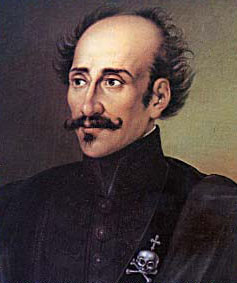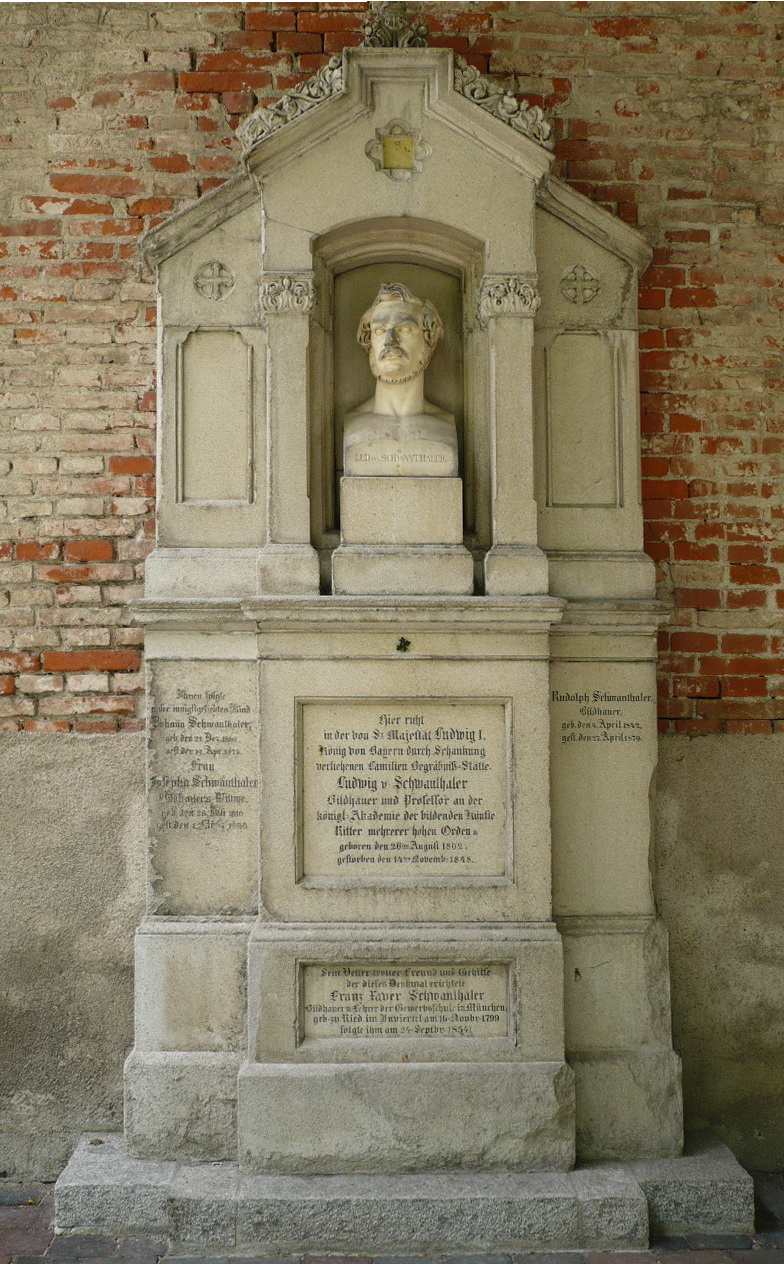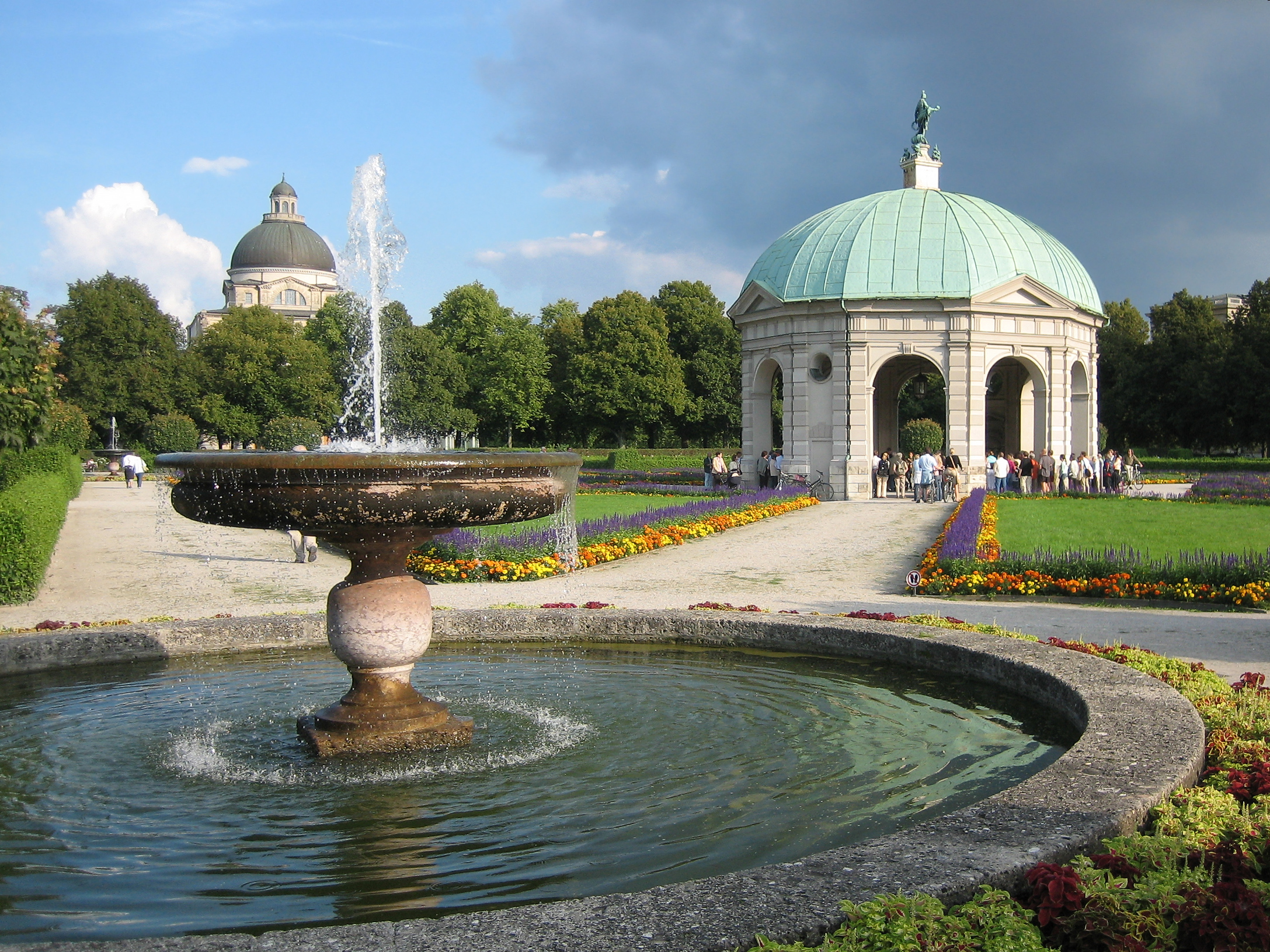|
Peter Von Hess
Peter Heinrich Lambert von Hess (29 July 1792 – 4 April 1871) was a German painter, known for historic paintings, especially of the Napoleonic Wars and the Greek War of Independence. Life Peter von Hess initially received training from his father Carl Ernst Christoph Hess. He accompanied his younger brother Heinrich Maria to Munich in 1806, and enrolled at the Munich Academy at the age of sixteen. He also trained under Wilhelm von Kobell. During the Napoleonic Wars, he was allowed to join the staff of General Wrede, who commanded the Bavarians in the military operations which led to the abdication of Napoleon. There he gained novel experiences of war and a taste for extensive travel. During this time, von Hess painted his first battle pieces. In 1818, he spent some time in Italy where he painted landscapes and various Italian scenes and travelled to Naples with Joseph Petzl and a group of other Bavarian artists. In 1833, at King Ludwig I of Bavaria's request, he accompanied ... [...More Info...] [...Related Items...] OR: [Wikipedia] [Google] [Baidu] |
Düsseldorf
Düsseldorf ( , , ; often in English sources; Low Franconian and Ripuarian language, Ripuarian: ''Düsseldörp'' ; archaic nl, Dusseldorp ) is the capital city of North Rhine-Westphalia, the most populous state of Germany. It is the second-largest city in the state and the List of cities in Germany with more than 100,000 inhabitants, seventh-largest city in Germany, with a population of 617,280. Düsseldorf is located at the confluence of two rivers: the Rhine and the Düssel, a small tributary. The ''-dorf'' suffix means "village" in German (English cognate: ''thorp''); its use is unusual for a settlement as large as Düsseldorf. Most of the city lies on the right bank of the Rhine. Düsseldorf lies in the centre of both the Rhine-Ruhr and the Rhineland Metropolitan Region. It neighbours the Cologne Bonn Region to the south and the Ruhr to the north. It is the largest city in the German Low Franconian dialect area (closely related to Dutch language, Dutch). World's Most Li ... [...More Info...] [...Related Items...] OR: [Wikipedia] [Google] [Baidu] |
Ludwig I Of Bavaria
en, Louis Charles Augustus , image = Joseph Karl Stieler - King Ludwig I in his Coronation Robes - WGA21796.jpg , caption = Portrait by Joseph Stieler, 1825 , succession=King of Bavaria , reign = , coronation = , predecessor = Maximilian I Joseph , successor = Maximilian II , birth_name = , birth_date = , birth_place =Strasbourg, Kingdom of France , death_date = , death_place =Nice, Second French Empire , spouse =Therese of Saxe-Hildburghausen , issue = Maximilian II of Bavaria Mathilde Caroline, Grand Duchess of Hesse and by Rhine Otto of GreecePrincess TheodelindeLuitpold, Prince Regent of Bavaria Adelgunde, Duchess of Modena Archduchess Hildegard of Austria Princess Alexandra Prince Adalbert , house =Wittelsbach , father = Maximilian I Joseph of Bavaria , mother = Princess Augusta Wilhelmine of Hesse-Darmstadt , religion =Roman Catholicism , burial_pl ... [...More Info...] [...Related Items...] OR: [Wikipedia] [Google] [Baidu] |
Sacred Band (1821)
The Sacred Band ( Greek: ) was a military force founded by Alexander Ypsilantis at the beginning of the Greek War of Independence, in the middle of March 1821 in Wallachia, now part of Romania. It was formed by volunteers students of the Greek communities of Moldavia, Wallachia and Odessa. It was the first organized military unit of the Greek War of Independence (1821) and of the Greek army in general. Ypsilantis thought that these young people could become the soul of his army. That was the reason that he borrowed the name of the Sacred Band of Thebes. Structure – Organization In Focșani, after the completion of the training of the Sacred Band's members, oath taking ceremony was organized, according to the Tsarist etiquette. After the ceremony, Alexander Ypsilantis gave an enthusiastic speech and gave the flag of the Sacred Band to the commander of the Band, Georgios Kantakouzinos (Athanasios Tsakalov, one of the founders of the Filiki Eteria was the second in command). ... [...More Info...] [...Related Items...] OR: [Wikipedia] [Google] [Baidu] |
Bouboulina
Laskarina Bouboulina ( el, Λασκαρίνα Μπουμπουλίνα; 1771 – 22 May 1825) was a Greek naval commander, heroine of the Greek War of Independence in 1821, and considered the first woman to attain the rank of admiral. She was born in Constantinople in 1771 into a family of Arvanite origin. During her youth she developed an interest in sailing which was facilitated by her stepfather's liberal attitude to education. She was widowed twice, inheriting a considerable sum of money from her second husband. She later joined the Filiki Etaireia secret society which sought to achieve Greek independence from the Ottoman Empire, being among the few women to do so. Following the outbreak of the Greek War of Independence she commanded a fleet of Spetsiot ships which contributed to several campaigns most notably the Siege of Nafplion. Following the defeat of her faction in the Greek civil war of 1824 she was expelled to Spetses and briefly imprisoned on false charges. She w ... [...More Info...] [...Related Items...] OR: [Wikipedia] [Google] [Baidu] |
Alexandros Mavrokordatos
Alexandros Mavrokordatos ( el, Αλέξανδρος Μαυροκορδάτος; 11 February 179118 August 1865) was a Greek statesman, diplomat, politician and member of the Mavrocordatos family of Phanariotes. Biography In 1812, Mavrokordatos went to the court of his uncle John George Caradja, Hospodar of Wallachia, with whom he passed into exile in the Austrian Empire (1818), where he studied at the University of Padua. He was a member of the Filiki Eteria and was among the Phanariot Greeks who hastened to Morea on the outbreak of the War of Independence in 1821. At the time of the beginning of the revolution, Mavrokordatos was living in Pisa with the poet Percy Bysshe Shelley and his wife Mary Shelley, and upon hearing of the revolution, Mavrokordatos headed to Marseilles to buy arms and a ship to take him back to Greece. Mavrokordatos was a very wealthy, well educated man, fluent in seven languages, whose experience in ruling Wallachia led many to look towards him as ... [...More Info...] [...Related Items...] OR: [Wikipedia] [Google] [Baidu] |
Andreas Vokos Miaoulis
Andreas Vokos, better known by his nickname Miaoulis ( el, Ανδρέας Βώκος Μιαούλης; 1765 – 24 June 1835), was a Greek revolutionary, admiral, and politician who commanded Greek naval forces during the Greek War of Independence (1821–1829). Biography Miaoulis was born on the island of Hydra to an Arvanite family of Euboean origin, namely from the town of Fylla. He was known among his fellow islanders as a trader in corn who had gained wealth and made a popular use of his money. He had been a merchant captain, and was chosen to lead the naval forces of the islands when they rose against the government of the Sultan. Miaoulis contributed in every way possible to the cause of the resistance against the Turks. He expended the money he had made from his wheat-shipping business during the Napoleonic Wars. Between May 1825 and January 1826, Miaoulis led the Greeks to victory over the Turks in skirmishes off Modon, Cape Matapan, Suda, and Cape Papas. Role in ... [...More Info...] [...Related Items...] OR: [Wikipedia] [Google] [Baidu] |
Alexander Ypsilantis (1792–1828)
Alexandros Ypsilantis ( el, Αλέξανδρος Υψηλάντης, Aléxandros Ypsilántis, ; ro, Alexandru Ipsilanti; russian: Александр Константинович Ипсиланти, Aleksandr Konstantinovich Ipsilanti; 12 December 179231 January 1828) was a Greek nationalist politician who was member of a prominent Phanariot Greek family, a prince of the Danubian Principalities, a senior officer of the Imperial Russian cavalry during the Napoleonic Wars, and a leader of the Filiki Etaireia, a secret organization that coordinated the beginning of the Greek War of Independence against the Ottoman Empire. Early life The Ypsilantis family hailed from the Pontic Greek population of Trabzon. He was born on 12 December 1792 in Constantinople, the capital of the Ottoman Empire, as the eldest of five brothers (the others being Demetrios, Nicholas, Georgios and Grigorios). His father Constantine Ypsilantis and grandfather Alexander were active in the Ottoman administ ... [...More Info...] [...Related Items...] OR: [Wikipedia] [Google] [Baidu] |
Munich
Munich ( ; german: München ; bar, Minga ) is the capital and most populous city of the German state of Bavaria. With a population of 1,558,395 inhabitants as of 31 July 2020, it is the third-largest city in Germany, after Berlin and Hamburg, and thus the largest which does not constitute its own state, as well as the 11th-largest city in the European Union. The city's metropolitan region is home to 6 million people. Straddling the banks of the River Isar (a tributary of the Danube) north of the Bavarian Alps, Munich is the seat of the Bavarian administrative region of Upper Bavaria, while being the most densely populated municipality in Germany (4,500 people per km2). Munich is the second-largest city in the Bavarian dialect area, after the Austrian capital of Vienna. The city was first mentioned in 1158. Catholic Munich strongly resisted the Reformation and was a political point of divergence during the resulting Thirty Years' War, but remained physically unt ... [...More Info...] [...Related Items...] OR: [Wikipedia] [Google] [Baidu] |
Alter Südfriedhof
The Alter Südfriedhof (''Old South Cemetery'') also known as "Alter Südlicher Friedhof" is a cemetery in Munich, Germany. It was founded by Duke Albrecht V as a plague cemetery in 1563 about half a kilometer south of the Sendlinger Gate between Thalkirchner and Pestalozzistraße. History The cemetery was established in 1563, during the reign of Albert V, Duke of Bavaria, for victims of the plague and located outside the city gates. It was also the burial ground of the dead from the Sendling uprising of 1705, in which over 1100 were killed after they had surrendered to the troops of Joseph I, Holy Roman Emperor. From 1788 to 1867 it was the single collective burial ground for the dead of the city. Notable interments From 1788 to 1868 it was the only cemetery for the whole metropolitan area of Munich, which is why it contains the graves of several prominent Munich figures of that period. * Max Emanuel Ainmiller – painter, 1807–1870 * Franz Xaver von Baader – ... [...More Info...] [...Related Items...] OR: [Wikipedia] [Google] [Baidu] |
Nauplia
Nafplio ( ell, Ναύπλιο) is a coastal city located in the Peloponnese in Greece and it is the capital of the regional unit of Argolis and an important touristic destination. Founded in antiquity, the city became an important seaport in the Middle Ages during the Frankokratia as part of the lordship of Argos and Nauplia, held initially by the de la Roche following the Fourth Crusade before coming under the Republic of Venice and, lastly, the Ottoman Empire. The city was the second capital of the First Hellenic Republic and of the Kingdom of Greece, from 1827 until 1834. Name The name of the town changed several times over the centuries. The modern Greek name of the town is ''Nafplio'' (Ναύπλιο). In English language, modern English, the most frequently used forms are ''Nauplia'' and ''Navplion''. In History of Europe#Early antiquity period, Classical Antiquity, it was known as ''Nauplia'' (Ναυπλία) in Attic GreekSee Liddell and Scott revised by Jones (1940), ... [...More Info...] [...Related Items...] OR: [Wikipedia] [Google] [Baidu] |
Hofgarten (Munich)
The Hofgarten (Court Garden) is a garden in the center of Munich, Germany, located between the Residenz and the Englischer Garten. History The garden was built in 1613–1617 by Maximilian I, Elector of Bavaria in the style of Italian Renaissance garden. In the center of the garden is a pavilion for the goddess Diana, built-in 1615 by Heinrich Schön the elder. A path leads from each of the eight arches. On the roof of the Diana pavilion, is the replica of a sculpture of Bavaria by Hubert Gerhard, created in 1623. The original is in the Kaisersaal of the Residenz. Facing the Hofgarten on the east side is the Bavarian Staatskanzlei ("State Chancellery"), housed in the former Army Museum, with the addition of glass wings left and right of the original building. The repurposed building was completed in 1993. A few steps more eastwards the Hofgartenkaserne was located from 1801 to 1899. In front of the Staatskanzlei, the Kriegerdenkmal ("war memorial") is located, built fo ... [...More Info...] [...Related Items...] OR: [Wikipedia] [Google] [Baidu] |
Nilsen
Nilsen is a surname of Norwegian origin, meaning "son of Nils". It refers to: *Adolf Nilsen (1895–1927), Norwegian Olympic rower * Alfred Nilsen (1892–1977), Norwegian politician; served one term in the Storting 1950–54 * Alfred Sigurd Nilsen (1891–1977), Norwegian politician; served three terms in the Storting * Anders Nilsen (other), several people * Arne Nilsen (1924–2020), Norwegian government minister *Achintya Holte Nilsen (born 1999) Indonesian-Norwegian model and activist * B. J. Nilsen (born 1975), Swedish sound artist * Betty Ann Bjerkreim Nilsen (born 1986), Norwegian orienteering competitor and cross country skier * Dennis Nilsen (1945–2018), British serial killer * Einar Nilsen (1901–1980), Norwegian Olympic boxer * Elin Nilsen (born 1968), Norwegian Olympic skier * Erling Nilsen (1910–1984), Norwegian Olympic boxer *Harald Christian Strand Nilsen (born 1971), Norwegian Olympic skier * Ida Nilsen (contemporary), Canadian singer and songwriter ... [...More Info...] [...Related Items...] OR: [Wikipedia] [Google] [Baidu] |





